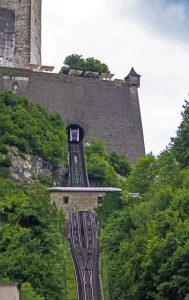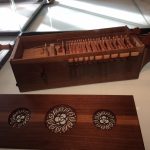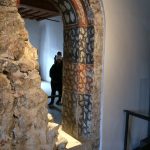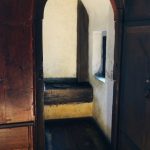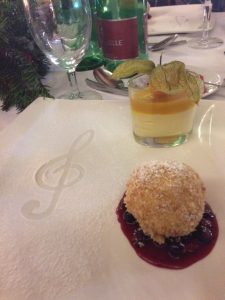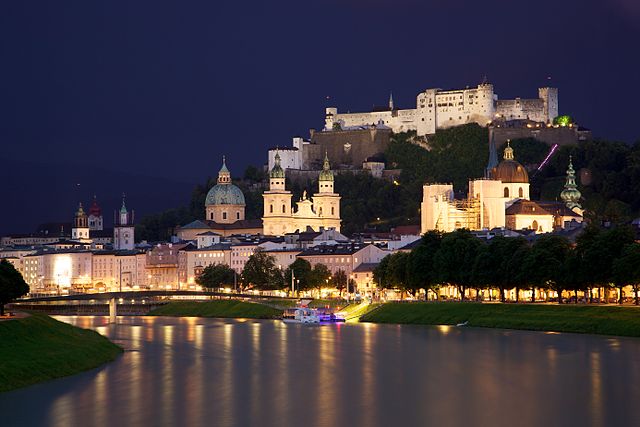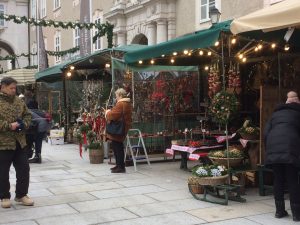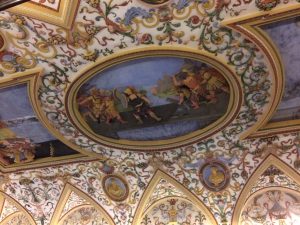Road Trip Through History: Salzburg, pt. 2 , The Hohen-Salzburg Fortress
If you only have time for one history nerd adventure in Salzburg, visit the Hohen-Salzburg Fortress. (aka the Festung Hohensalzburg). It will give you a literal overview of the city and its history, and a glimpse of some breathtaking medieval living spaces.
The fortress was built in several stages, beginning in 1077 during the reign of Archbishop Gebhard I von Helfenstein, who reportedly was a bit nervous as a result of the Investiture Controversy between the presumptive Holy Roman Emperor Henry V and papal reformer Pope Gregory VII. (The archbishop, not surprisingly, was on Team Pope. ) Today, the fortress is billed as the largest, best preserved castle in Europe. Like other big hunks of medieval rock that I’ve described on this blog,(1) the Hohen-Salzburg Fortress is built on the high ground. (2) In 1898, long after the archbishops ceased to be secular princes, Salzburg constructed a funicular to make it easier to visit the fortress. The funicular is still a popular way to reach the top, though you can walk up if you are feeling zippy.
Once you’ve made your way to the top, the fortress is divided into several different exhibits:
- •An excellent audio tour that leads you through the walls of the fortress and onto the top of one of the towers. (And those of you who’ve been hanging out here on the Margins for a while know that I am not a huge fan of audio tours, if for no other reason than they make it impossible to take notes.)
- The fortress museum, which gives you a glimpse of life within the fortress walls, including the “golden rooms”, aka the personal chambers of the Archbishop Leonhard von Keutschach, who reigned from 1495 to 1519. (3)
- A regimental museum—which I am really glad I went through but which may not be your cup of gulaschsuppe
- A marionette museum, which has nothing to do with fortress per se, though it does include two films of aspects of Salzburg history starring marionettes. Basically, the museum is a spin-off of the city’s excellent Marionette Theater— which is well worth a visit.
Here are a few bits that stuck with me:
Music in Salzburg didn’t begin with Mozart. More than 100 handwritten musical manuscripts are attributed to the “Monk of Salzburg” who lived in the court of the Archbishop Pilgrim von Purcheim (1365-96). He wrote both secular and sacred songs, in an early polyphonic style. I looked for recordings of his work among all the Mozart, with no success. The search is on!
Archbishop Leonhard inherited a state on the skids and rebuilt it into one of the richest and most powerful states in the Holy Roman Empire. As might be expected, he stepped on some toes in the process. Facing difficulties with the burgers of the city, who had been granted the right to an elected council by the Holy Roman Emperor under Leonhard’s predecessor, he invited them to dinner at the fortress to discuss matters. (Word to the wise: accepting invitations of this sort is never a good idea.) Once they were in the fortress he held them captive until they renounced their rights. Incidentally, his family crest was a turnip.
- A medieval hurdy gurdy
- A Romanesque wall found in the interior of the fortress during construction
- One of Leonhard’s luxuries was a personal water closet (known at the time as a garderobe) off his bedroom.
All told, the fortress was a high point of the trip. (Sorry. I couldn’t resist.)
(1) For instance, Dover Castle and Mont St. Michel
(2) This is defensive architecture 101. In fact, the first permanent towns that we know of are those of the tel culture, built around the eighth or ninth century BCE in what is now Palestine. The name comes from the Arabic word for hill, and in fact many of these small towns were built on hills—their natural defenses reinforced with massive defensive walls, built of rubble mortared together with mud. The most well known of these fortified hill towns is the multi-layered site of Jericho, also known as Tel es-sultan, located on the Palestinian West Bank. But I digress.
(3) Just to put him in context:
Isabella of Castile reigned from 1474 to 1504
Columbus sailed the ocean blue in 1492
Copernicus published his theory that the earth moves around the sun in 1514
Luther published his 95 theses in 1517
———————————————————
A few practical tips for those who want to conquer the castle:
• The various parts of the museum control access so it is never crowded. The flip side of this is that eventually the crowd backs up. Get there early to avoid standing in lines. By the time we were leaving (around noon), the line for the main fortress exhibit stretched outside the main building and toward the walls.
*You already know this, but wear layers. I was very grateful that My Own True Love reminded me that big hunks of rock are hard to heat and that it is often windy on top of battlements. The weather was mild, but I was happy to have that vest on under my coat.
*Live music is everywhere in Salzburg all year long, including the Fortress. Every Sunday musicians perform baroque fanfares from the “Trumpeter Tower.” The fortress is also a venue for a concert series. We attended a lunch concert at the fortress on Christmas Day: the food was nothing special, but the music was fabulous.
Road Trip Through History: Salzburg, Pt. 1
My Own True Love and I did not come to Salzburg with history on our minds.(1) We were focused on Christmas markets, the 200th anniversary of Silent Night, a little Mozart, the possibility of skiing (2), traditional Austrian cuisine,(3) and the romance of waltzing in a public square at midnight on New Year’s Eve.
The 200th anniversary of Silent Night proved to be our downfall. On our first full day in Salzburg we stopped at the Salzburg Museum to see a special exhibit titled Silent Night 200: The History, The Message, The Present. With a little extra time before the museum closed, we poked our respective noses into rooms of the permanent exhibit and were hooked. (Though really, the Silent Night exhibit was enough to hook us all by itself.) After all, history buggs are going to history bugg even over the holidays.
The Silent Night exhibit placed the creation of the song in the context of what was happening in Salzburg at the time. The city had been under duress for several years. The French plundered it during the Napoleonic wars. Like much of Europe, it suffered crop failures and food shortages in 1816 (“the year without summer”). That same year, after being shuffled back and forth between Austria and Bavaria, Salzburg was annexed by the Hapsburg monarchy, losing both its autonomy and its role as a regional capital. In 1818, the city suffered a major fire. No wonder Franz Gruber and Joseph Mohr wrote so longingly for peace.
As far as I’m concerned, the song remains bigger than the historical context in which it was created. But setting the song in context made it clear to me that, while I have a pretty firm grasp on the big sweep of events that affected Salzburg, I had no real sense of how they played out at the local level. A lesson I apparently have to learn over and over again. Luckily, the rest of the Salzburg Museum was there to fill in the gaps. We were back on the day after Christmas for an unplanned museum visit.
I won’t try to give you a comprehensive history of Salzburg. Instead, here are the bits that particularly caught my imagination:
• A small exhibit in a passageway between the Salzburg Museum and its adjunct, the Panorama Museum, shows the development of the city at four stages of its history, beginning with the Roman town of Iuvavum, founded in 15 BCE and ending with the nineteenth century. The exhibit was clearly intended to lead the visitor toward Johann Michael Sattler’s in-the-round painting of Salzburg. (4) What I took away instead was a sense of continuity over centuries.
• For most of its history, Salzburg was an episcopal state, ruled by a prince-archbishop, rather than a city. At times the land under its control was almost as large as modern Austria. It was one of the wealthiest and most powerful states in the Holy Roman Empire, thanks to salt, gold, copper, marble, timber, and rich farmland. Not surprisingly, the prince-archbishops came down on the side of the pope during the conflict between the Holy Roman Emperor and the pope known as the Investiture Controversy, a subject I spent a lot of time wrestling with last year. (5) Also not surprisingly, they were not in favor of the Reformation. In fact, in 1731-2, prince-archbishop exiled more than 20,000 Protestants from the city—almost twenty percent of its population. They fled to East Prussia, the Netherlands, and North America. Salzburg’s loss; our gain.
• The development of tourism was a conscious choice, which grew out of the the city’s connection to the international railroad system and the opening of the Salzburg train station in 1860. Developers created a Neustadt of grand hotels, spas, salons, parks and promenades to support a summer season for wealthy guests. The historic heart of the city—the largely Baroque Altstadt—became a stage for social events. The exhibit’s curator did an excellent job of depicted the conflict between historic preservation and development that was and remains an inherent part of the tourist industry.
• I was halfway through the museum before I realized I needed to look up. The museum is housed in the baroque-era residence of the prince-archbishops, known as the New Residence. (As opposed to its medieval predecessor. New is relative.) The well-designed exhibit space is modern. The ceilings are pure baroque.
(1) Though I packed Mark Kurlansky’s Salt: A World History as my serious travel read because salt clearly played a major role in the city’s history. (As Kurlansky makes clear, this did not make Salzburg unique.)
(2) For other members of our party. I’m not a winter sports fan.
(3) Weiner schnitzel, wursts of various kinds, gulaschsuppe, strudel, tortes….
(4) Sattler traveled throughout Europe with the painting from 1829-1839. It is very nice, but a pale shadow of the Gettysburg Cyclorama. Sorry, Salzburg.
(5) Here’s the short version: The Investiture Controversy was the culmination of several generations of conflict that centered on the relationship between religious and secular power in general and the relative power of the papacy and the Holy Roman Emperor in particular. The issue at the heart of the Investiture Controversy was not the separation of church and state--a concept that would have made no sense to anyone involved--but over who controlled appointments to church offices and consequently the wealth and power which church officials wielded. Secular rulers had long exercised the authority to not only appoint bishops and abbots in their realms, but to perform the ritual that installed them in office. The long-standing conflict came to a head with the consecration of the reformist monk Hildebrand as Pope Gregory VII in 1073. Under Gregory's leadership, the church issued sweeping reforms for its clergy, including bans on married clergy and simony, or trafficking in ecclesiastical offices. Gregory expanded the definition of simony to include lay investiture of bishops. His ban on lay investiture of bishops was more than a religious reform. It also struck at the power of secular leaders.
_______________________________________________________________
A few practical travel notes:
Traditional Austrian food, is easy to find in Salzburg, but it varies in quality. I highly recommend both the Gasthof Goldgasse and the Zipfer Bierhaus.
When we reached the point where all the menus seemed to blur together, we were unexpectedly wowed with the food at Bio Burger Meister.
My Own True Love and I were both fascinated by a guided tour of the halls where the concerts of the annual Salzburg festival are held. The halls were originally built in 1606 and served as stables and riding schools for first the Salzburg and later the Austro-Hungarian cavalry through 1918. Today they are glorious performance spaces. If you are interested in buildings and/or the performing arts, put this on your to-do list.
Looking Ahead to Another Year of History Buff-ery
 It’s become a tradition here on the Margins that I use my first blog post of the year to share the historical topics that I hope/plan/expect to read, write and think about over the course of the coming year. It’s the mental equivalent of writing thank-you notes (1), clearing out the Christmas clutter, and setting up my calendar on New Year’s Day. A way of clearing the decks for action. A little self-indulgent perhaps, but I hope some of you find it thought provoking.
It’s become a tradition here on the Margins that I use my first blog post of the year to share the historical topics that I hope/plan/expect to read, write and think about over the course of the coming year. It’s the mental equivalent of writing thank-you notes (1), clearing out the Christmas clutter, and setting up my calendar on New Year’s Day. A way of clearing the decks for action. A little self-indulgent perhaps, but I hope some of you find it thought provoking.
2018 brought no surprises. Women Warriors was my primary focus(,2) though I did take some side excursions to consider D-Day, William the Conqueror, and the Great River Road.
Women Warriors and women warriors will continue to be a big deal for me in 2019. I’m already lining up speaking gigs and podcast appearances and blog interviews. (3) But history buff does not live by women warriors alone. Here are some other historical topics that I expect to be thinking about in 2019:
1. Women’s history in general (I’ve got some great stuff lined up for the blog in Women’s History Month.)
2. The suffragist movement in particular, as well as all the ways that women began to push against the norm at the end of the nineteenth and beginning of the twentieth centuries
3. The development of the toy industry (4)
4. World War II aviation (unavoidable if you spend any time with My Own True Love), as well as the related topic of plane-spotting.
If I’m lucky, something totally unexpected will catch my imagination. (I love a good detour.) If it does, I’ll let you know.
What kind of history buff stories are you pursuing into the new year?
(1) Yes. Honest-to-dog illegible handwritten thank-you letters on note cards.
(2) And rightly so.
(3) And speaking of speaking: I’m not going to clog up my blog posts with all the details of when and where, though I will list them on the newsletter. If you’re interested in following along, you can check the events page on this blog. If you belong to a group that needs speakers ( Historical society? Service league? Book club? AAUW chapter? Knitting circle? Revolutionary cell?), give me a shout at pdtoler@sbcglobal.com. I can’t promise, but I’ll do my best to make it work, by Skype if not in person.
(4) Bet you didn’t expect that one.

